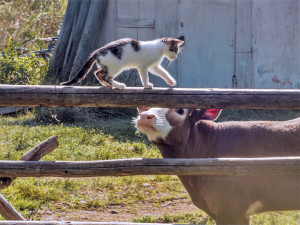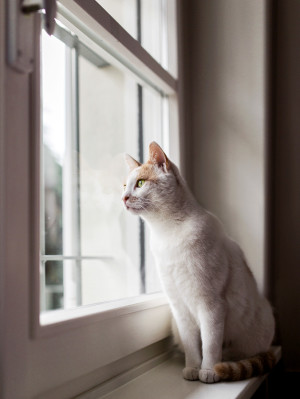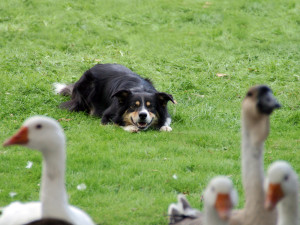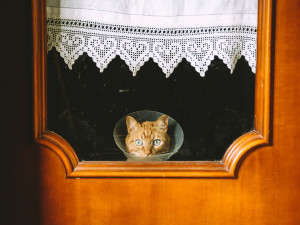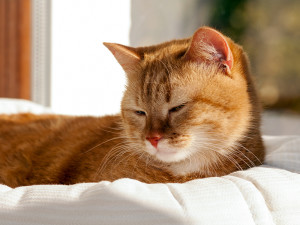Bird Flu Is Infecting Cats Across The Country—Including Indoor Ones
Nearly 40 domestic cats have been infected with bird flu—two of which have never been outside.

Share Article
Since March of 2024, the Centers for Disease Control and Prevention (CDC) has warned against widespread occurrences of H5N1opens in new tab — aka avian influenza, aka “bird flu” — in mammals across the United States. Since then, at least 37 domestic cats have been infected with the potentially fatal disease, according to data collected by the U.S. Department of Agriculture’s Animal and Plant Health Inspection Service (APHIS)opens in new tab — and some of those cats have never stepped a paw outside.
Earlier this month, the Colorado Department of Public Health announcedopens in new tab that six domestic cats were diagnosed with avian influenza. One cat’s infection was associated with a nearby dairy facility experiencing an outbreak. Three of the cats lived both indoors and outdoors and hunted small prey, including mice, which may have been infected with bird flu. But unusually, two of the cats were indoor cats with no known direct exposure to avian influenza — a development that is causing some experts concern.
How did indoor cats become infected with bird flu?
Scientists are still trying to determine how the two cats became sick without known exposure to bird flu. Cats primarily become infected with bird flu by eating sick or infected birds; there have also been cases of cats getting sick after drinking raw, unpasteurized milk that came from H5N1-infected cows. But these new cases are different: The two indoor cats had no reported exposure to farms or farm animals.
One possibility is that the cats became sick after eating bird-flu infected mice that had entered the house. “Mice can be infected but I’d expect that to mainly be a risk in houses very close to poultry or dairy farms with active infections, since mice don’t move very far,” Dr. Scott Weese,opens in new tab an infectious disease veterinarian, told The Telegraph. It is not publicly known how close the infected cats lived to farms.

Alternately, the cats could have acquired bird flu from an infected human in the house who was asymptomatic, or a human could have tracked in secretions from an infected bird or farm animal. Since there is limited information on the indoor cats, it’s also possible that the cats consumed raw milk or meat from an infected animal — or even that they spent some time outdoors, contrary to their pet parents’ report.
“This identification of H5N1 in indoor-only cats is a big concern,” Dr. Meghan Davis,opens in new tab an epidemiologist at the Johns Hopkins Bloomberg School of Public Health, told Scientific American. “Increasing our surveillance and trying to understand the scope of this and get better messaging out is something I think we should be doing right now.”
Can cats pass bird flu to humans?
It’s technically possible for humans to get bird flu from other mammals, but it’s extremely rare. There has only been one reported case opens in new tab of a human becoming infected with avian influenza after contact with a sick cat, and there have been no cases of mammals giving the bird flu to humans during this most recent outbreak. “Animals other than birds are considered ‘dead-end hosts,’ meaning that while they may show symptoms of the virus, the virus cannot infect them as efficiently as it does in birds, and therefore these other species are less likely to be able to spread the virus to others,” Dr. Fox said.
To be safe, the CDC recommends veterinarians and others interacting with sick cats use protection such as gloves, googles, and masks. “While it’s unlikely that people would become infected with bird flu viruses through contact with an infected wild, stray, feral, or domestic cat, it is possible — especially if there is prolonged and unprotected exposure to the animal,” said the CDC.opens in new tab “Sick animals may be able to transmit influenza virus to people in their saliva, feces or droppings, and other body fluids. Human infections can occur when the virus is inhaled or gets into a person’s eyes, nose, or mouth.”
How to keep cats safe from bird flu — and what symptoms to look out for.
While it’s important to be aware of the presence of bird flu, there’s no need to panic: It remains very rare for cats and dogs to become sick with avian influenza. In general, the CDC maintains that the risk of bird fluopens in new tab to the public is low. However, if your cat lives in or near a farm or in an area where there have been reported outbreaks of avian influenza, you should keep an eye out for symptoms of the virus. “Some signs could include fever, lethargy, difficulty breathing, coughing, runny nose, and/or signs of conjunctivitis which includes red eyes, eyes that appear squinty or sealed shut, and/or eyes with goopy greenish yellow discharge,” veterinarian Dr. Amy Fox told us.opens in new tab Other symptoms include lethargy, depression, and confusion.
If your pet shows symptoms of illness after exposure to birds or cows who may have avian influenza, they should see a veterinarian immediately. Cats should be kept away from livestock, and the CDC recommends that pets and humans do not consume raw milk, unpasteurized cheeses, or undercooked meat.
References
Avian Influenza A (H7N2) in Cats in Animal Shelters in NY; One Human Infectionopens in new tab
Bird Flu Is Infecting Pet Cats. Here’s What You Need to Knowopens in new tab
Detections of Highly Pathogenic Avian Influenza in Mammalsopens in new tab
Indoor house cats have died of bird flu. How did they get it?opens in new tab
Influenza A (Highly Pathogenic Avian Influenza H5N1) in domestic catsopens in new tab

Sio Hornbuckle
Sio Hornbuckle is the Assistant Editor at Kinship, where they frequently write for the site. As a writer, they specialize in pet news, animal science, and pop culture. They live in New York City with their cat, Toni Collette.
Related articles
![White Cat And His Reflection On Window While He Stares At The Outside.]()
Your Cat Wants to Go Outside More Than Anything — Should You Let Them?
The pros and cons of letting your cat explore the neighborhood (and beyond).
![Woman and dog sitting outside.]()
A Rabies-Infected Bat Was Found In Pasadena—Here’s What Pet Parents Should Know
August and September are the most active months for rabid bats. Here’s how to keep your pet safe.
![Dog on ground looking at geese]()
What to Know About Bird Flu in Cats and Dogs
Several cats and one dog in North America have died of the virus. Here’s how to keep them safe.
![cat with cone after vet visit]()
How Often Should You Take Your Cat to the Vet?
Get thy cat to a vet, even if it’s a struggle to get them out the door.
![Red cat with squinted eyes laying in a basket closeup]()
6 Ways Your Cat Could Tell You They Are in Pain
Here are all the way your kitty is trying to tell you they’re hurting.
Can Cats Get Fevers?
And how to know if they have one.
